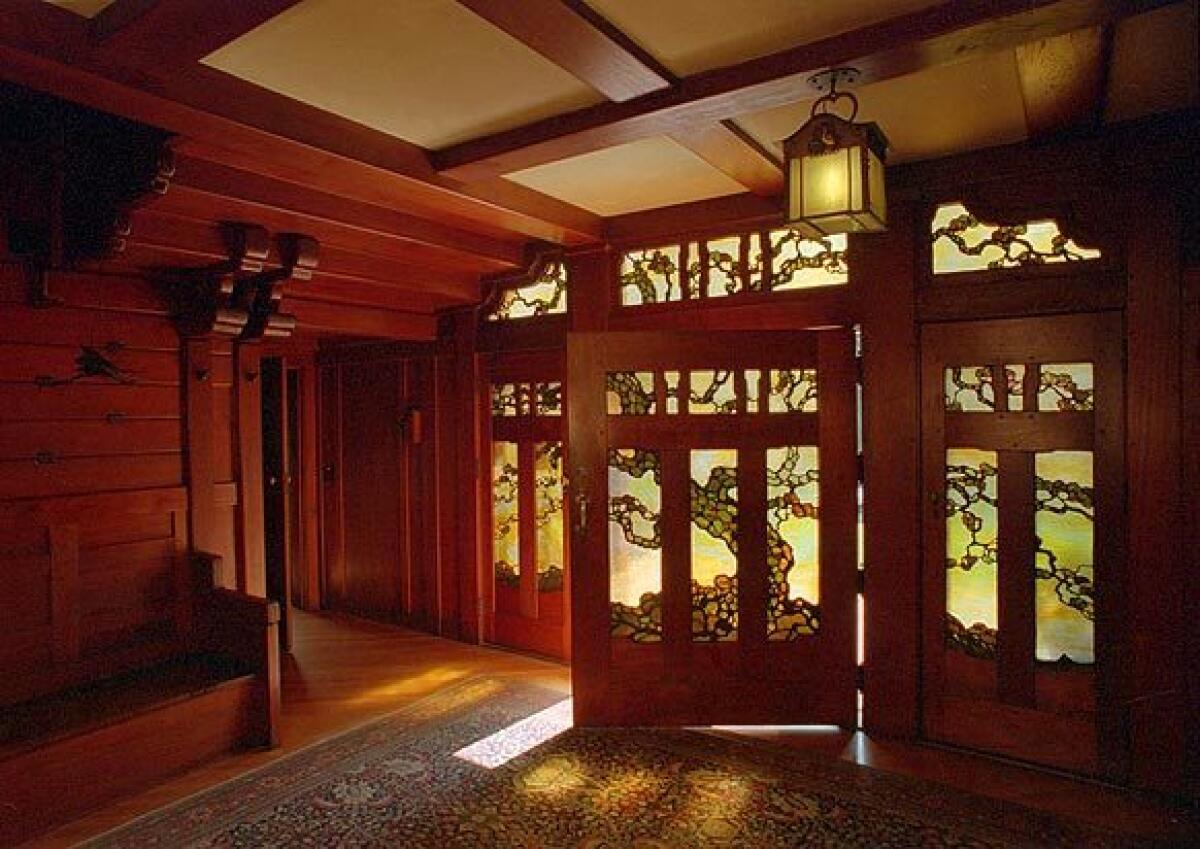USC to relinquish control of the Gamble House in Pasadena
- Share via
After five decades of managing the Gamble House — crown jewel of Pasadena, international pilgrimage site for devotees of the Arts and Crafts style and point of pride for USC’s School of Architecture — the university is giving up oversight of the historic home to more local supporters.
The Pasadena City Council last week approved the transfer of operations from USC to the new Gamble House Conservancy, pending court approval, said Mayor Terry Tornek, who also serves on the Gamble House’s board of governors.
The move significantly alters the long relationship between the university and the house, built in 1909 and given to Pasadena in 1966 with the stipulation that USC manage its operations. It was designated a National Historic Landmark in 1978.
Tornek said negotiations among the city, the Gamble family and USC have been “amicable.” Although the original agreement called for USC to manage the house for 99 years, Tornek said two volunteer organizations dedicated to preservation of the house — the Docent Council of the Gamble House, which runs tours, and the Friends of the Gamble House, which has been instrumental in fundraising — have proved their ability to preserve and operate the beloved landmark.
“These are not rookies,” Tornek said. “These are people who have been associated with historic preservation and the house for years.”
The ability of the Gamble House’s supporters to manage the site is “far beyond what anybody imagined,” Tornek said. “Pasadena now has historic preservation baked into our culture ... and there was a sense locally that it would be a preferred course of action to have the house be under local control.”
His grass orbs burst through the sidewalk at the Broad museum. Meet the MacArthur Fellow bringing the past into the landscape of the present.
The university will keep a strong presence at the house, Tornek said. It still will have access to Gamble House meeting rooms, and academic programs related to the house will continue, as will the resident scholar program, which each year allows two USC architecture students to live in the house.
“The USC School of Architecture believes this decision is in the best interest of the Gamble House and will help secure its status as an educational institution of benefit to the public,” the university said in a statement. “The shared mission of the past five decades has been to inspire the public’s appreciation, understanding and support of historic architecture, and we will continue to work with the new Gamble House Conservancy to achieve this.”
Tornek said the goal is to finalize the transfer by year’s end. The new agreement, he said, will allow the house to operate more efficiently and with a broader reach, unencumbered by university restrictions.
“We couldn’t have accomplished this without their full cooperation,” Tornek said of USC.
The new Gamble House Conservancy board has 10 members, including President David Brown, former president of the ArtCenter College of Design in Pasadena, and Robert Harris, former dean of the USC School of Architecture. The remaining members all served in various capacities for the Docent Council of the Gamble House or Friends of the Gamble House.

A prime example of American Arts and Crafts architecture, the Gamble House was designed by brothers Charles and Henry Greene for Procter & Gamble heir David Gamble and his wife, Mary. The house has become a tourist attraction, a magnet for architecture fans and a feather in the cap of USC’s architecture school, which has touted its stewardship of the Gamble House as well as of Frank Lloyd Wright’s Freeman House (1924).
An Oct. 7 city of Pasadena staff report to the City Council said, “Although operating, preserving, maintaining and repairing the Gamble House is a significant financial commitment that USC was well suited to take on in 1966, circumstances have changed significantly.”
Tornek said the house’s endowment now stands at about $8 million. He would not disclose the annual operating budget, but a 2018 letter to donors written by Brown said donations, ticket sales and annual earnings from the house’s endowment are “sufficient to support the house’s entire operating cost.”
The change to the 1966 operating agreement requires court approval because the original donors of the property are deceased. If approved, the Gamble House Conservancy will maintain and operate the landmark and the city will continue to pay for utilities, landscaping and certain property maintenance in accordance with historical precedent. Public access, including tours and events at the house, “would be consistent with those in the past,” the city’s report said.
Support our continuing coverage of California architecture and preservation issues. Become a digital subscriber.
Change is coming to Los Angeles’ La Brea Tar Pits and possibly its beloved, tar-trapped mammoth. Three acclaimed architecture firms unveiled proposals to remake the site.
More to Read
The biggest entertainment stories
Get our big stories about Hollywood, film, television, music, arts, culture and more right in your inbox as soon as they publish.
You may occasionally receive promotional content from the Los Angeles Times.











